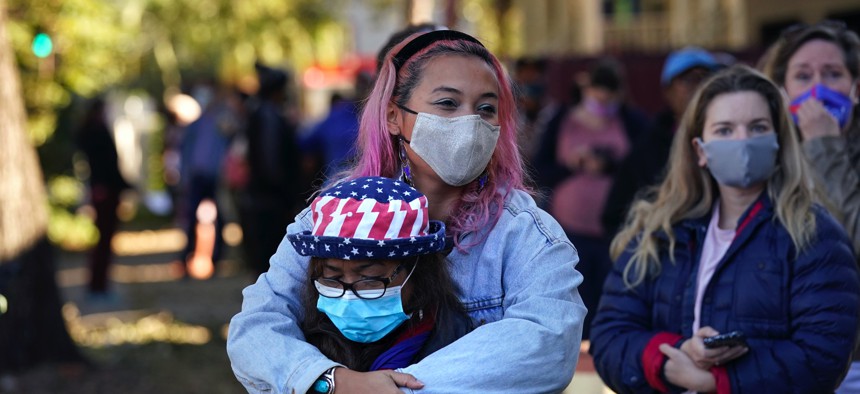
AP Photo/Gerald Herbert Voters wait in line to cast ballots in New Orleans, Louisiana, on Nov. 3, 2020.
A Quiet Day At The Polls For Most Americans
Security experts still fear late-night violence and clashes in the days to come, but so far, the worst-case scenario has not come to pass.
In downtown districts across the country, retail and restaurant owners had boarded up their storefronts in nervous anticipation of election-related unrest. National Guard officials sought to play down fears that they would be called up to address violence or voter intimidation at the polls, insisting that local and federal law enforcement would handle any disturbances — something for which Justice Department officials were actively planning.
But by the time most polls had closed on the East Coast, the worst of Americans’ fears about Election Day violence had not come to pass. Americans voted in the tens of millions with few reports of irregularities. A spokesman for the National Guard Bureau, Army Master Sgt. Michael Houk, said late on Tuesday morning that regional rapid response units created in September to respond quickly to state governor’s requests for law enforcement assistance received no requests.
The regional response units — about 600 service members split evenly between Arizona and Alabama — ”are equipped with airlift resources and military police units that allow them to be fully deployed within 24 hours of anywhere in the nation,” the Guard spokesman said. Guard officials are careful not to explicitly link the units to fears of election violence; the units were formed after widespread unrest engulfed the country over the summer in response to the killing of George Floyd, a Black man, by police in Minneapolis in May.
As the clock ticked toward midnight in Washington, D.C., none had been needed. Although some states had called up their National Guards to assist with cybersecurity and routine poll administration — for which Guardsmen dressed in civilian clothes — there had been no widespread reports of voter intimidation or clashes between armed groups of protesters on Tuesday.
In North Carolina, the Charlotte Mecklenburg Police Department arrested an armed man who returned to a polling place after being banned earlier in the day, after receiving a call “regarding Dunn possibly intimidating other voters,” according to a statement.
President Donald Trump stoked fears that right-wing militia groups supporting his candidacy, like the Oath Keepers, would heed his calls to supporters to “watch” polls to prevent what he falsely described as rampant election fraud. The plot to kidnap Gov. Gretchen Whitmer by anti-government extremists opposed to the Michigan chief executive’s coronavirus restrictions further raised fears in the run-up to Nov. 3.
On Monday night, Trump tweeted that a recent Supreme Court decision allowing Pennsylvania to continue counting mail-in ballots postmarked before the election but received after Nov. 3 “will allow rampant and unchecked cheating” and “induce violence in the streets,” adding: “Something must be done!” (Twitter masked the tweet, requiring viewers to click through and read a warning that some of its content “might be misleading about an election or other civic process.”)
On the cyber and information technology front — another key concern for election officials heading into Nov. 3 — the big story was the lack of story.
“Pretty vanilla,” said a senior official with the Cyber Infrastructure Security Agency, or CISA, on a call with reporters late Tuesday evening. “Just another Tuesday on the Internet.”
A spattering of technical disruptions across the country had no material effect on voting, even if they did pose an inconvenience to some voters, CISA officials said. In Franklin County, Ohio, a glitch in electronic pollbooks — lists of voter information — forced a quick move to paper backups, resulting in a slight delay. Misleading robocalls in Nebraska, Iowa, Michigan, North Carolina, Kansas, and Virginia told voters that if they encountered long lines, they could vote tomorrow, but CISA officials said such calls were an expected occurrence during every election and local officials were quick to counter the misleading information.
But CISA officials were hesitant to sound an all-clear. As votes are counted in an unusual election that saw historic levels of mail-in voting, the coming days and even months will be a “prime landscape for disinfo,” said one official. In short, the threat has shifted away from disrupting the actual electoral process to manipulating perceptions of the process.
Security experts monitoring the election warn that there is still potential for unrest after Election Night and throughout the week, in particular if there is no definitive winner on Tuesday night — as appears increasingly likely. Trump campaign advisor Jason Miller falsely claimed on Sunday that Democrats would try to “steal” electoral votes from Trump if the president appeared to be ahead in the returns on Tuesday, by counting valid mail-in ballots after Nov. 3. Trump has repeatedly declined to say if he will accept the results of the election if he loses to Democratic nominee Joe Biden.
As of this writing, large crowds were gathered in front of the White House — the site of one of the summer’s most violent confrontation between law enforcement and protesters, when U.S. Park Police tear-gassed protesters to clear the way for President Trump to walk to a nearby church for a photo op.
There was at least one scuffle, as of 10 p.m., between Black Lives Matter activists and a person yelling “All Lives Matter.”
Patrick Tucker contributed to this article.




